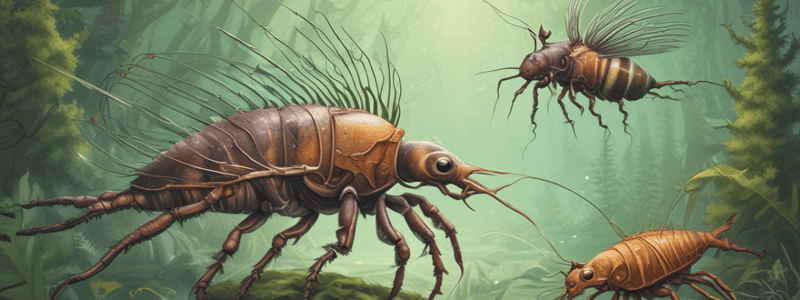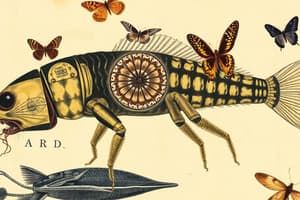Podcast
Questions and Answers
What is the characteristic feature of the Bilateria group?
What is the characteristic feature of the Bilateria group?
- Bilateral symmetry (correct)
- Asymmetry
- Radial symmetry
- No symmetry
Which phylum consists of terrestrial animals important for soil ecosystems?
Which phylum consists of terrestrial animals important for soil ecosystems?
- Mollusca
- Ectoprocta
- Brachiopoda
- Annelida (correct)
Which of the following phyla is not a subdivision of the Lophotrochozoa clade?
Which of the following phyla is not a subdivision of the Lophotrochozoa clade?
- Annelids
- Echinodermata (correct)
- Platyhelminthes
- Mollusca
What is the characteristic feature of the hydrostatic skeleton in Platyhelminthes?
What is the characteristic feature of the hydrostatic skeleton in Platyhelminthes?
What is a characteristic feature of the phylum Brachiopoda?
What is a characteristic feature of the phylum Brachiopoda?
Which class of annelids is characterized by having many bristles?
Which class of annelids is characterized by having many bristles?
What is the function of the Oracle in Platyhelminthes?
What is the function of the Oracle in Platyhelminthes?
What is the characteristic feature of the Cestoda group?
What is the characteristic feature of the Cestoda group?
What is a unique reproductive feature of some annelids?
What is a unique reproductive feature of some annelids?
Which of the following phyla is NOT a member of the clade Trochozoa?
Which of the following phyla is NOT a member of the clade Trochozoa?
What is the characteristic feature of the Rotifera group?
What is the characteristic feature of the Rotifera group?
Which type of annelid is known for its parasitic nature and numbing saliva?
Which type of annelid is known for its parasitic nature and numbing saliva?
What is a characteristic feature of the body of a nematode worm?
What is a characteristic feature of the body of a nematode worm?
What is the primary function of parasitic nematodes?
What is the primary function of parasitic nematodes?
Where can nematodes be commonly found?
Where can nematodes be commonly found?
What is a unique feature of the digestive system of nematodes?
What is a unique feature of the digestive system of nematodes?
Why are pinworms commonly found in homes?
Why are pinworms commonly found in homes?
What is the primary component of the hydrostatic skeleton of nematodes?
What is the primary component of the hydrostatic skeleton of nematodes?
What is the primary function of the exoskeleton in arthropods?
What is the primary function of the exoskeleton in arthropods?
Which arthropod group is characterized by having six legs?
Which arthropod group is characterized by having six legs?
What is the process by which arthropods shed their old exoskeleton to grow?
What is the process by which arthropods shed their old exoskeleton to grow?
Which of the following arthropod groups includes scorpions?
Which of the following arthropod groups includes scorpions?
What is a characteristic feature of trilobites?
What is a characteristic feature of trilobites?
What is the primary function of the notochord in chordates?
What is the primary function of the notochord in chordates?
Which of the following echinoderm classes is characterized by having a long and flexible body?
Which of the following echinoderm classes is characterized by having a long and flexible body?
What is the primary function of the coelom in echinoderms?
What is the primary function of the coelom in echinoderms?
What is a characteristic feature of echinoderm fertilization?
What is a characteristic feature of echinoderm fertilization?
What is the primary difference between the circulatory system of echinoderms and that of chordates?
What is the primary difference between the circulatory system of echinoderms and that of chordates?
Which of the following is a characteristic feature of chordates, but not echinoderms?
Which of the following is a characteristic feature of chordates, but not echinoderms?
What is the primary function of the spongo coel in sponges?
What is the primary function of the spongo coel in sponges?
What is the main criterion for classifying sponges?
What is the main criterion for classifying sponges?
Which type of cell is involved in digestion and nutrient distribution in sponges?
Which type of cell is involved in digestion and nutrient distribution in sponges?
What is the function of the ostia in sponges?
What is the function of the ostia in sponges?
What is the characteristic feature of the class Hexactinellida of sponges?
What is the characteristic feature of the class Hexactinellida of sponges?
What is the term for the 'pore-bearing' characteristic of sponges?
What is the term for the 'pore-bearing' characteristic of sponges?
What is a characteristic feature of the body organization of Cnidarians?
What is a characteristic feature of the body organization of Cnidarians?
What is the function of the gastrovascular cavity in Cnidarians?
What is the function of the gastrovascular cavity in Cnidarians?
What is a unique feature of the skeletal system of Cnidarians?
What is a unique feature of the skeletal system of Cnidarians?
What is the characteristic feature of the nerve system of Cnidarians?
What is the characteristic feature of the nerve system of Cnidarians?
What is a characteristic feature of the class Anthozoa in Cnidaria?
What is a characteristic feature of the class Anthozoa in Cnidaria?
What is a characteristic feature of Phylum Ctenophora?
What is a characteristic feature of Phylum Ctenophora?
What is the primary function of the radula in molluscs?
What is the primary function of the radula in molluscs?
Which of the following is an adaptation of gastropods?
Which of the following is an adaptation of gastropods?
What is a characteristic feature of the molluscan body plan?
What is a characteristic feature of the molluscan body plan?
What is a characteristic feature of the life cycle of many marine molluscs?
What is a characteristic feature of the life cycle of many marine molluscs?
Which of the following classes of molluscs is characterized by having oval shapes and shells divided into eight dorsal plates?
Which of the following classes of molluscs is characterized by having oval shapes and shells divided into eight dorsal plates?
What is a characteristic feature of the visceral mass in molluscs?
What is a characteristic feature of the visceral mass in molluscs?
What is the primary function of the mantle cavity in terrestrial snails?
What is the primary function of the mantle cavity in terrestrial snails?
What is the primary function of the gills in bivalves?
What is the primary function of the gills in bivalves?
What is the primary function of the radula in molluscs?
What is the primary function of the radula in molluscs?
What is the primary function of the adductor muscles in bivalves?
What is the primary function of the adductor muscles in bivalves?
What is the primary function of the cilia in bivalves?
What is the primary function of the cilia in bivalves?
What is the primary function of the excurrent siphon in bivalves?
What is the primary function of the excurrent siphon in bivalves?
What is the primary function of the radula in gastropods?
What is the primary function of the radula in gastropods?
What is the result of torsion during embryonic development in gastropods?
What is the result of torsion during embryonic development in gastropods?
What is a characteristic feature of the shells of abalones and limpets?
What is a characteristic feature of the shells of abalones and limpets?
What is the function of the radula in some predatory gastropod species?
What is the function of the radula in some predatory gastropod species?
What is the approximate percentage of all living mollusc species that are gastropods?
What is the approximate percentage of all living mollusc species that are gastropods?
What is the mechanism of movement used by some gastropods?
What is the mechanism of movement used by some gastropods?
Flashcards are hidden until you start studying
Study Notes
-
The majority of animals are classified in the evolutionary group known as Bilateria, characterized by bilateral symmetry.
-
Within the Bilateria clade, there are three subdivisions: Deuterostomia, Ecdysozoa, and Lophotrochozoa.
-
The Lophotrochozoa clade is a diverse group of animals, including Platyhelminthes, Annelids, Mollusca, and others.
-
Platyhelminthes, also known as flatworms, have a flattened body, compressed dorsoventrally, and are characterized by cephalization.
-
Platyhelminthes have a head region with sensory organs, including Oracle (chemo-receptors) and eye spots that detect light.
-
They have a gastrovascular cavity with a single opening for food and waste, and a hydrostatic skeleton that relies on a tough cuticle, muscle cells, and water pressure.
-
Subdivisions of Platyhelminthes include Turbellaria (free-living flatworms), Trematoda (flukes, parasitic flatworms), and Cestoda (tapeworms).
-
Turbellaria, such as planarians, are free-living and feed on decomposing matter or other organisms.
-
Trematoda, such as liver flukes, are parasitic and require multiple hosts to complete their life cycle.
-
Cestoda, such as tapeworms, are parasitic and have a chain-like body composed of individual segments (proglottids) that are attached to each other.
-
Rotifera, also known as wheel animals, are characterized by the presence of a corona (a ring of cilia) that creates a spinning motion.
-
Rotifera have a complete digestive system, a pseudo-coelom (a cavity between the ectoderm and endoderm), and are mostly parthenogenetic (reproducing without mating).
-
Brachiopoda, also known as lamp shells, are characterized by a feeding structure called a lofophore.
-
Brachiopoda have a mouth surrounded by cilia and a hard exoskeleton that is secreted by the mantle.
-
Ectoprocta, also known as bryozoans, are marine animals that form colonies and have a hard exoskeleton.
-
Mollusca, such as mollusks, are characterized by the presence of a mantle, a soft body, and a well-developed muscular foot.
-
Mollusca have a coelom (a body cavity) that is reduced in size, and a heart that is encased in the coelom.
-
Subdivisions of Mollusca include Polyplacophora (chitons), Gastropoda (snails and slugs), Bivalvia (clams and mussels), and Cephalopoda (octopuses and squids).
-
Annelids, such as earthworms and leeches, are characterized by the presence of a true coelom and a complete digestive system.
-
Annelids have a body that is divided into segments, each with a serial homolog (a similar structure), and some have setae (bristle-like extensions).
-
Earthworms are terrestrial annelids that are important for soil ecosystems.
-
Leeches are annelids that are parasitic and feed on the blood of other animals.
-
Some annelids, such as Christmas tree worms, have a concentration of sensory organs around the head region.- Earthworms can undergo asexual reproduction, where if cut in a specific location, each broken part can grow into a new worm, resulting in two worms from one.
-
Polykita is a class of annelids characterized by having many bristles, which can be seen on the lateral sides of the animal.
-
Oligokita is a class of annelids characterized by having few bristles, which can be felt as roughness on the body of an earthworm, similar to stubble on a man's face.
-
Earthworms are familiar animals, but some species in Australia can grow up to nine feet in length, comparable to the length of a python.
-
Hirudinea is a class of annelids that includes leeches, some of which are parasitic and secrete a numbing agent in their saliva, making it impossible to feel when they attach to the body.
-
Leeches can be found in waters and can attach to the body, but their local anesthetic properties make it difficult to detect their presence.
-
The clade Trochozoa includes a diverse range of invertebrates, including annelids and mollusks.
Studying That Suits You
Use AI to generate personalized quizzes and flashcards to suit your learning preferences.




